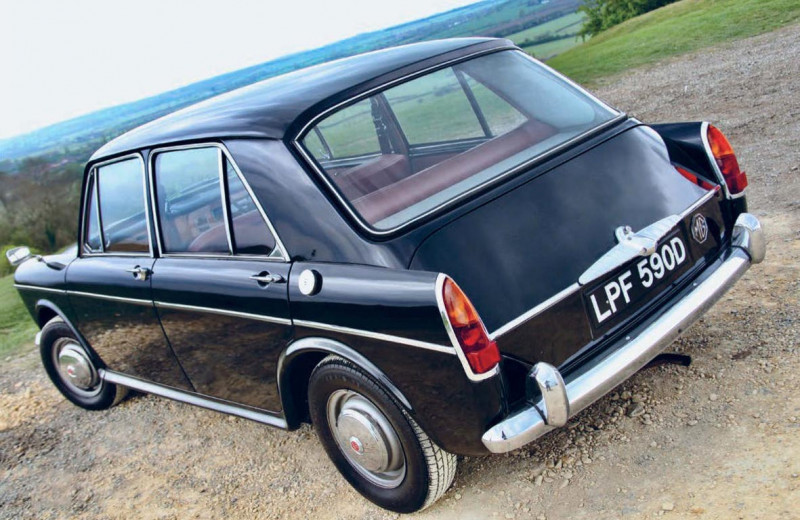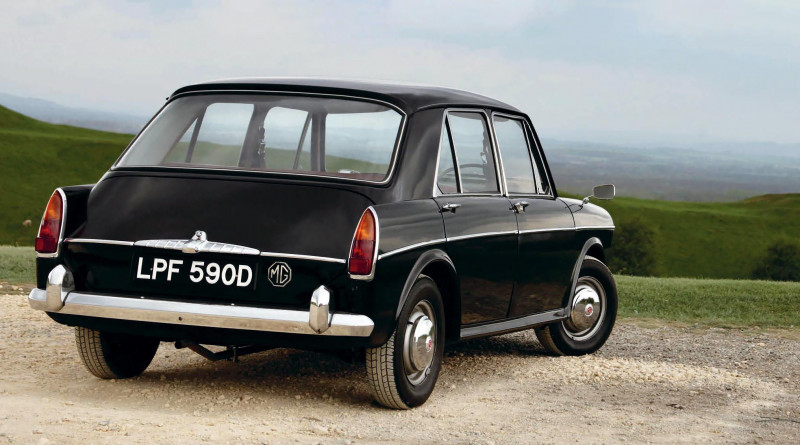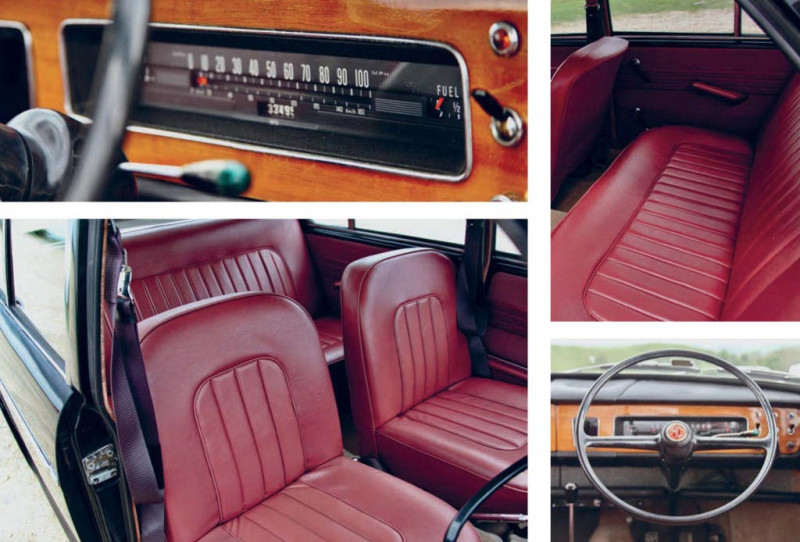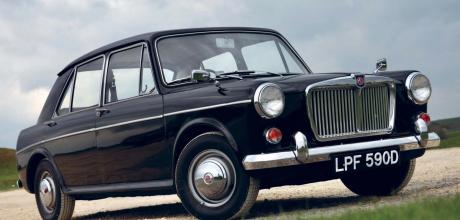MG 1100/1300 at 60
This year marks the 60th anniversary of the first-ever front-wheel-drive MG: the 1100 sports saloon. Little did MG know at the time that it would become the mould for future generations of Octagon-badged cars…
SIXTY GLORIOUS YEARS
MG 1100/1300 at 60
MG’s first small saloon car celebrates a major milestone – we track down a stunning example to mark the occasion
WORDS AND PHOTOGRAPHS: CRAIG CHEETHAM
In 1962, the British Motor Corporation pulled the wraps off its new ‘ADO16’ saloon car – a multi-branded model that would evolve the ‘badge engineering’ seen on BMC’s larger saloons since 1955, and which had been a huge success for the company on its ‘Farina’ saloon cars; the MG variant of which was the MG Magnette Mk 3.

The new compact saloon, with its maximised cabin space and bouncy ‘Hydrolastic’ suspension, was a perennial best-seller not only for BMC but for the UK as a whole, topping the nation’s sales charts from 1963 until 1969. It wore six badges in total: Austin and Morris at launch, then MG, Riley, Vanden Plas and Wolseley. The MG was the third model, introduced soon after launch as a more sporting alternative to the bread-and-butter Austin and Morris cars.

Incidentally, the Moulton Hydrolastic suspension had been scheduled to appear first on the Mini (ADO15) in 1959 but they could not get it ready in time so the BMC 1100/1300 was the first model to be produced with it. The Mini didn't get it until some time in 1964 – and on some models only.] The 1100 was quite revolutionary and was described in all the promotional literature as: «the most advanced MG of all time!» It’s a statement that no doubt raised a few eyebrows from the ranks of diehard enthusiasts, many of whom pooh-poohed the car at launch as an unwelcome exercise in badge-engineering.
DESPITE ITS LUKEWARM WELCOME FROM PURISTS, THE CAR WAS AN OUTSTANDING SUCCESS FROM THE START

After all, MG was a sports car brand and, with a modest 55bhp at launch, the 1100 was no performance saloon. But it was a hugely important car for business. The MGA was struggling sales-wise and the new MGB was imminent but not quite ready, so ADO16 was an essential car to keep the MG brand front-of-mind.
The MG 1100 also had an important part to play in the growth of BMC in the early sixties. Originally, plans were afoot to make an MG version of the revolutionary Issigonis Mini that had been introduced in 1959. However, the infamous deal with John Cooper Garages that led to the giant-killing Mini Cooper put paid to that, as the Mini Cooper became synonymous with motorsport and tuning instead. Many design exercises were produced by the Abingdon Drawing Office, some of which were two-seater based, but a Mini-based MG never happened, much to the delight of Alec Issigonis who did not think the front-wheel-drive set-up was suitable for a sports car.
It was a desire to conquer America that gave rise to an MG variant of the 1100, as the brand was BMC’s best-known badge in the US. With this front-of- mind, the badge-engineered MG 1100 was launched in the summer of 1962. Despite its lukewarm welcome from purists, the car was an outstanding success from the start. Compared with Austin and Morris models, the MG version was far better appointed throughout, with a twin carburettor engine and a distinctive MG front grille. Like all ADO16s, it was capable of carrying four adults with comfort and room to spare, while the Hydrolastic, fluid-filled suspension gave exceptional ride characteristics and entertaining handling. It was the first and only time that the system was used on an MG, though the later MG Metro and MGF used its Hydragas successor, an evolution of the Hydrolastic set-up. This new kind of suspension used a water-based damping fluid to apply dynamic force to rubber cone spring units. The fluid provided the necessary damping to the suspension, thus eliminating the need for shock absorbers altogether.

Hydrolastic suspension also removed the pitching problems associated with standard suspension because front and rear units were inter-connected. Pitching movements were all but eliminated because shocks to the suspension were instantly smoothed out as the fluid passed from front to rear. Under the bonnet, the MG 1100 had BMC’s familiar A-series engine in 1,098cc form, mounted transversely in the front subframe with the gearbox installed in the sump and sharing the engine oil, as per the Mini. It had a respectable top speed of 88mph, despite a modest 55bhp output, and was as easily tuned as any other A-series. The 1100 was launched in twodoor form only, with a four-door soon following in 1963. This is because it was felt internally that two doors went better with the sporting MG image. The sales figures proved different: over two-thirds of MG 1100s ended up being four-door models.
The MG Sports Sedan, as it was marketed, cost £949. However, there was a problem identifying which market MG was aiming at, with literature and promotional films showing it as an ideal shopping car and, at the other extreme, a car suitable for club racing. Either way it sold slowly, with nearly 28,000 being sold over a period of 5 years. It didn’t help that it was almost £300 dearer than an Austin 1100 and, while far better appointed, many buyers elected not to pay the premium.

As for the accoutrements… leather trim, thick carpets, a wooden dash, a unique waffle-effect boot mat and fullsize door cards were the main standouts, along with a distinct front panel incorporating the MG chrome grille and octagon badge and MG wheel trims. By 1967, the 1100 was beginning to look somewhat dated and its initially respectable performance, economy and handling were being surpassed by competitors. Ford’s all-new Escort was gearing up usurp the 1100/1300 as Britain’s best-seller; something it achieved by 1970.
To keep up, British Leyland (as it had now become) gave the 1100/1300 range a facelift. It got new, larger rear light clusters, ventilated pressed steel wheels and revised seats, while the new interior was now largely shared with Wolseley and Riley variants.
The MG version had its engine capacity increased to 1,275cc and unusually, given the sales figures, was offered only with a two-door body. BL’s thinking was to differentiate it from the others and market it as a sporty, premium car at a price to match. The fascia and instrumentation were dramatically improved and included a rev counter. Although initially known as the MG 1275 it soon became known as the MG 1300 Mark I. The MG 1100 continued to be made and was available alongside the 1300 for a short period, at a lower price.
Four-speed AP automatic transmission was now an option on the new 1300 but, in this case, a single SU carburettor was used. In manual form the engine produced a healthy 75bhp and a close-ratio, four-speed, four-synchromesh gearbox was fitted. The model remained largely unchanged until it was discontinued in 1971 in favour of the Austin/Morris 1300 GT; the only changes being in late 1968 when the Mark II version was introduced which adopted the Riley’s walnut veneer facia, complete with rev counter and a three-spoke alloy sports steering wheel. The 1100/1300, in its others guises, was itself replaced in 1973 by the Austin Allegro, with BL preferring a singlemarque rationalisation process. The idea of a front-drive MG was laid to rest until 1982 when the MG Metro reinvigorated the idea. It, too, has a significant birthday this year and will be celebrated in MGE later this year.
The MG 1100 and 1300, meanwhile, are now some of the rarest MG models in the UK, with around 300 of both variants believed still to survive. If you can find one, they’re lovely, usable and enjoyable classics that are the perfect garage companion to an MG sports car. Huge thanks to Adam Marshall for the use of his gorgeous 1966 MG 1100 for photography.
THE IDEA OF A FRONT-WHEEL-DRIVE MG WAS THEN LAID TO REST UNTIL 1982, WHEN THE METRO REINVIGORATED THE CONCEPT
Specifications: MG1100/1300
- Engine: 4-cylinder, transversely mounted.
- Capacity: 1,098cc/1,275cc
- Max power: 55bhp @ 5,500 rpm/75bhp @ 6,000rpm
- Gearbox: four-speed, synchromesh on 2, 3 and 4 or automatic, transmission in sump
- Brakes: Hydraulic, discs at front, 8" drums at rear.
- Wheels: Ventilated, pressed steel 4Jx12
- Suspension: Front; independent upper and lower arms with Hydrolastic displacers. Rear:
- independent with trailing arms incorporating Hydrolastic displacers.
- Number built: 27,814 (1100); 26,240 (1300)
- Body type: 2-door and 4-door saloon.
THE NEW COMPACT SALOON, WITH ITS MAXIMISED CABIN SPACE AND BOUNCY ‘HYDROLASTIC’ SUSPENSION, WAS A PERENNIAL BEST-SELLER NOT ONLY FOR BMC BUT FOR THE UK AS A WHOLE



The MG was actually the second one in the 1100 range to be launched; the Morris came first, in summer 1962, with the MG in autumn the same year, but the Austin did not appear till 1963. I was the owner of the black car pictured above until about 2011 when I sold it and bought an MG 1300 Mk II the following January.
The unusual colour of the upholstery is called terracotta, and since 2017 I have owned a virtually identical C-reg MG 1100.